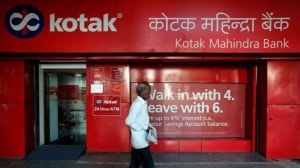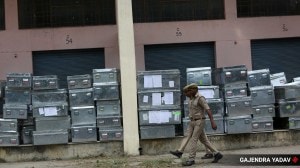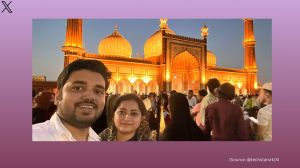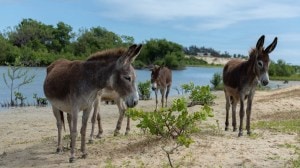- India
- International
History Headline: How the world’s first vaccine came to India
Only a determined vaccination campaign backed by the World Health Organisation, involving the mass mobilisation of health workers and citizens in surveillance and containment measures, secured local eradication of small pox in 1975.
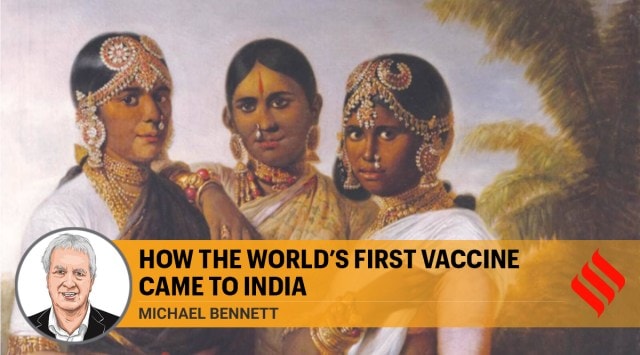 This portrait by Thomas Hickey commemorates the vaccination of the Mysore maharaja’s second queen (right). (Source: Sotheby’s)
This portrait by Thomas Hickey commemorates the vaccination of the Mysore maharaja’s second queen (right). (Source: Sotheby’s)Written by Michael Bennett
Older people will remember the horror of smallpox. It was a deadly virus, with a case fatality rate of more than one in four, far higher than Covid.
The vaccine for smallpox, the world’s first vaccine, came to India in 1802. By then, Indians had been living with the disease for centuries. In larger cities, smallpox was ever present. In rural areas, especially in south India, it appeared in epidemic form every few years.
In 1798, Edward Jenner, an English physician, published his thesis that inoculation of cowpox, a pustular disease found on the udders of cows, provided full and safe protection from smallpox. Clinical trials in London in 1799 confirmed his experiments, and over the following year, cowpox or vaccine inoculation, as it was first termed, began to win acceptance in England and attracted interest overseas, including in colonial India.
Jenner regarded his discovery as a global good and sought to make the vaccine freely available worldwide. The problem was that cowpox was rare even in England. From the outset, vaccine supply depended on the practice of vaccination. The vesicle rising on the arm of a vaccinated child was lanced to provide lymph for other children. Practitioners also dried lymph on cotton threads for their future use and for dispatch to colleagues to seed the practice elsewhere.

From 1800 onwards, Jenner and others sent vaccine samples by sea to India, but the vaccine had a short shelf life, especially in hot and humid climates. Early in 1802, improvements in packaging made it possible to send viable vaccine from Vienna to Baghdad, where a British surgeon propagated fresh vaccine on local children for transmission to Bombay.
The first vaccination in India took place in June 1802. The patient was Anna Dusthall, a young, mixed-race girl in then Bombay. From the vesicle on her arm other children were vaccinated, establishing the practice locally and making samples available for dispatch inland to Poona, and from there, town to town down the Malabar coast, up to Madras, and thence by sea to Calcutta.
The live vaccine was maintained by vaccinating children in one place and then escorting them to another district to go arm-to-arm with children there. All the vaccinations in India for about 20 years were from stock derived from the girl in Bombay.
Large-scale vaccination took place in the British areas of control. In the presidency of Madras, Indian practitioners were paid for the numbers vaccinated, and hundreds of thousands of people were vaccinated in a few years. Swamy Naik, an army surgeon, clocked up 900,000 vaccinations during his career, probably a world record.
There were inevitable challenges in establishing the practice across India. Texts on vaccination were translated into Sanskrit, Hindi, Tamil and other languages. There was some hope initially that Hindus would welcome the association with the cow. While many Brahmins endorsed the new practice, there was naturally a great deal of hesitancy about inoculating an animal disease and passing it from body to body across religious and caste lines.
To maintain a supply of vaccine, it was often necessary to entice poor parents to bring forward their children with doles of rice and trinkets.
In a bid to dispel some of the misgivings, Indian rulers, many of whom had western doctors in their service, led the way in having their families vaccinated.
After the British occupation of Delhi in 1805, Shah Alam, the Mughal Emperor, had his grandchildren vaccinated. Raja Serfoji of Tanjore (Thanjavur), passionate about science, took up vaccination himself.
At the royal court of Mysore, vaccination was already well regarded in 1805, when the raja took a second wife who was still susceptible to smallpox. It was decided that she should be vaccinated before the marriage, an event that, according to historian Nigel Chancellor, was commemorated by Irish-born painter Thomas Hickey in a group portrait, in which the young queen is depicted pointing to the site of vaccination.
In the first decade of the practice, there were over a million vaccinations in India. India became a centre of vaccination activity, spreading the practice around the Indian Ocean and southeast Asia region, and conducting new experiments in delivery.
Over the following 150 years, hundreds of millions of Indians were vaccinated and there was some success in containing the ravages of the disease.
However, with a growing and more mobile population, logistical problems and vaccination failures, mistrust of western medicine and sheer apathy, smallpox remained a major public health issue at the time of Independence. Even as late as 1963, there were over 25,000 smallpox deaths in India.
Only a determined vaccination campaign backed by the World Health Organisation, involving the mass mobilisation of health workers and citizens in surveillance and containment measures, secured its local eradication in 1975.
The writer is Emeritus Professor of History, University of Tasmania, and the author of War Against Smallpox. Edward Jenner and the Global Spread of Vaccination
EXPRESS OPINION
More Explained
Apr 24: Latest News
- 01
- 02
- 03
- 04
- 05




















